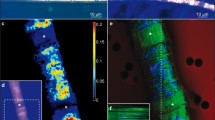Abstract
Cells of the coccolithophoridCricosphaera elongata (Droop) Braarud (Prymnesiophyceae) were concentrated by means of tangential ultrafiltration. Ultrastructural features of control cells were typical of the genusCricosphaera. The flagellar apparatus consists of two flagella, a bulbous haptonema, an axosome and a basal helical band, as recently reported in the literature for another coccolithophorid. We observed a very-well developed Golgi apparatus, displaying all the features of the “peculiar” Golgi of the Prymnesiophytes. Observations with the light microscope did not reveal any difference between control algae and algae contaminated with 1, 10 and 20 µmol Cd 1−1 (i.e., 112 µg 1−1, 1.12 and 2.24 mg Cd 1−1) for 48 h. However, algae treated with the highest cadmium concentration exhibited loss of motility after 6 h contact, but without apparent ultrastructural damage. Qualitative X-ray microanalysis of the dense granules present in Golgi vacuoles of control cells demonstrated the presence of calcium and chlorine and, at a lower level, sulphur and aluminium. The same elements were also identified in the dense part of the lysosomes. In situ,C. elongata produces coccoliths; this did not occur in culture. However, the coccolith-generating apparatus (Golgi complex and Ca2+) was present in culture, and the cells were able to synthesize unmineralized scales.
Similar content being viewed by others
Literature cited
Beech, P. L., Wetherbee, R. (1988). Observations on the flagellar apparatus and peripheral endoplasmic reticulum of the coccolithophoridPleurochrysis carterae (Prymnesiophyceae). Phycologia 27: 142–158
Borman, A. H., de Jong, E. W., Huizinga, M., Kok, D. J., Westbroek, P., Bosch, L. (1982). The role in CaCO3 crystallization of an acid Ca2+-binding polysaccharide associated with coccoliths ofEmiliania huxleyi. Eur. J. Biochem. 129: 179–183
Braarud, T. (1960). On the coccolithophorid genusCricosphaera n. gen. Nytt Mag. Bot. 8: 211–212
Droop, M. R. (1955). Some new supra-littoral Protista. J. mar. biol. Ass. U. K. 34: 233–245
Duret, S., Bonaly, J., Bariaud, A., Vannereau, A., Mestre, J. C. (1986). Cadmium-induced ultrastructural changes inEuglena cells. Envir. Res. 39: 96–103
Fresnel, J. (1989). Les coccolithophorides (Prymnesiophyceae) du littoral: genres:Cricosphaera, Pleurochrysis, Cruciplacolithus, Hymenomas etOchrosphaera. Ultrastructure, cycle biologique, systématique. Thèse de Doctorat d'Etat. Université de Caen
Gnassia-Barelli, M., Roméo, M. (1987). Uptake of zinc by cultured phytoplanktersHymenomonas elongata. Dis. aquat. Organisms 3: 45–49
Gnassia-Barelli, M., Roméo, M., Laumond, F., Pesando, D. (1978). Experimental studies on the relationship between natural copper complexes and their toxicity to phytoplankton. Mar. Biol. 47: 15–19
Guillard, R. R. L., Ryther, J. H. (1962). Studies of marine planktonic diatoms. I.Cyclotella nana Hustedt andDetonula confervacea (Cleve) Gran. Can. J. Microbiol. 8: 229–239
Heuillet, H., Moreau, A., Halpern, S., Jeanne, N., Puiseux-Dao, S. (1986). Cadmium-binding to a thiol molecule in vacuoles ofDunaliella bioculata contaminated with CdCl2: electron probe microanalysis. Biol. cell. 58: 79–86
Hibberd, D. J. (1980). Prymnesiophytes (= Haptophytes). In: Cox, E. R. (ed.) Phytoflagellates. Elsevier, North-Holland, New York, p. 273–317
Inouye, I., Pienaar, R. N. (1985). Ultrastructure of the flagellar apparatus inPleurochrysis (class Prymnesiophyceae). Protoplasma 125: 24–35
Karez, C. S. (1989). Les métaux et les algues marines: toxicité et accumulation du zinc et du cadmium chez deux espèces unicellulaires:Cricosphaera elongata etAcetabularia acetabulum. Thèse de doctorat en toxicologie fondamentale et appliquée. Université de Paris VII
Karez, C. S., Allemand, D., de Renzis, G., Gnassia-Barelli, M., Roméo, M., Puiseux-Dao, S. (1990). Ca-Cd interaction in a PrymnesiophyceaeCricosphaera elongata. Pl., Cell Envir. 13: 483–487
Marano, F. (1980). Synchronisation et cycle cellulaire deDunaliella bioculata. Utilisation de ce modèle expérimental pour l'étude du mode d'action de l'acroléine. Thèse de Doctorat d'Etat. Université de Paris VII
Outka, D. E., Williams, D. C. (1971). Sequential coccolith morphogenesis inHymenomonas carterae. J. Protozool. 18: 285–297
Reynolds, E. S. (1963). The use of lead citrate at high pH as an electron-opaque stain in electron microscopy. J. Cell Biol. 17: 208–212
Roméo, M. (1985). Contribution à la connaissance des métaux traces (Cd, Cu, Hg, Pb, Zn) dans l'écosystème marin au niveau du plancton. Approches analytiques et expérimentales. Thèse de Doctorat d'Etat. Université de Nice
Roméo, M., Gnassia-Barelli, M., Karez, C. S., Puiseux-Dao, S. (1989). Cadmium uptake by a phytoplankton species in the presence of different inhibitors. Toxic. envirl Chem. 22: 97–100
Soyer, M. P., Prévot, P. (1981). Ultrastructural damage by cadmium in a marine dinoflagellate,Prorocentrum micans. J. Protozool. 28: 308–313
Wal, van der, P., de Jong, E. W., Westbroek, P., de Bruijn, W. C., Mulder-Stapel, A. A. (1983a). Polysaccharide localization, coccolith formation, and Golgi dynamics in the coccolithophoridHymenomonas carterae. J. Ultrastruct. Res. 85: 139–158
Wal, van der, P., de Jong, L., Westbroek, P., de Bruijn, W. C. (1983b). Calcification in the coccolithophorid algaHymenomonas carterae. Ecol. Bull., Stockholm 35: 251–258
Watson, M. L. (1958). Staining of tissue sections for electron microscopy with heavy metals. J. biophys. biochem. Cytol. 4: 475–485
Westbroek, P., de Jong, E. W., van der Wal, P., Borman, A. H., de Vrind, J. P. M., Kok, D., de Bruijn, W. C., Parker, S. B. (1984). Mechanism of calcification in the marine algaEmiliana huxleyi. Phil. Trans. R. Soc. (Ser. B) 304: 435–444
Author information
Authors and Affiliations
Additional information
Communicated by J.M. Pérès, Marseille
Rights and permissions
About this article
Cite this article
Henry, M., Karez, C.S., Roméo, M. et al. Ultrastructural study and calcium and cadmium localization in the marine coccolithophoridCricosphaera elongata . Mar. Biol. 111, 167–173 (1991). https://doi.org/10.1007/BF01986358
Accepted:
Issue Date:
DOI: https://doi.org/10.1007/BF01986358




